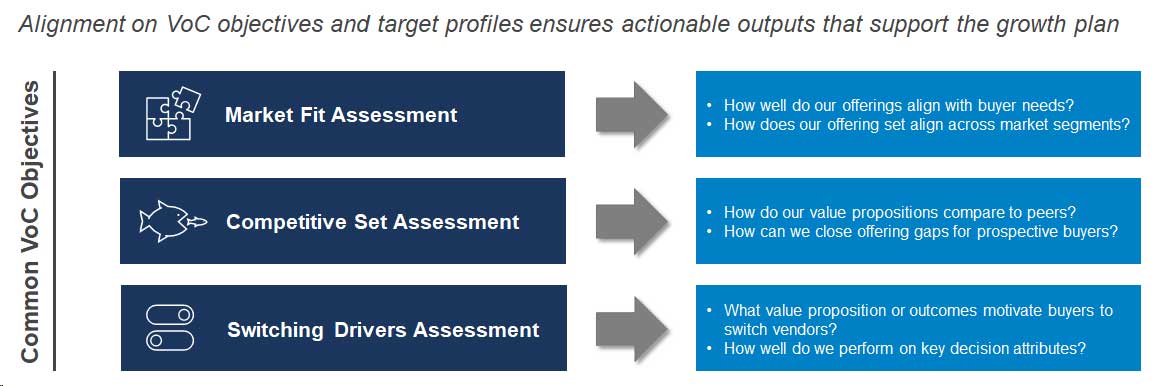Insights Alone Have Limited Value
Harvesting rich customer insights is not a standalone winning strategy; to recognize value from VoC capabilities organizations must link research to quantitative evaluation of their existing go-to-market (GTM) motions to improve operational performance. Organizations need to understand where their GTM strategy is missing the mark – is there a slowdown in new customer acquisition? Lagging reorder or expansion opportunities? Increase in customer churn? By identifying the area of the business that is suffering the most, leaders can improve the yield of their customer research efforts.
Below are five common areas organizations look to in order to turn research into actionable insights:
- WHO are our core buyers: Validating or updating Ideal Customer Profiles (ICP)
- HOW do we reach them: Re-evaluating marketing channels and campaigns to reach ICP
- WHY do they choose us: Optimizing product positioning and value proposition
- WHAT do they need: Informing product development and product lifecycle planning
- WHERE do we see growth: Updating customer segmentation to align sales/marketing resources
Optimizing across these areas will improve organizational efficiency on the path toward profitable growth.
From Tactical Optimization to Opportunity-Based Transformation
All organizations outgrow their commercial operating models as they scale with new products and into adjacent markets. While customer research can easily identify refinements in the current GTM model, leaders that have determined their model is no longer ‘fit for purpose’ on their next wave of profitable growth can leverage these insights to better redesign their customer targeting, coverage and deployment plans.
Redesigning the GTM model typically focuses on addressing either a disconnect in customer experience delivery (e.g., unavailable field sales covering customers preferring fast, digital engagement) or customer opportunity (e.g., targeting prospects unlikely to purchase). Combining VoC research with modern machine learning techniques provides sales and marketing leaders with new visibility both into where growth exists in their customer/prospect universe and how to quantify the account-level opportunity. In his piece on multi-variable regression models and account targeting, Alexander Group Director Sean Backe explains how new methodologies such as K-Means clustering are enabling leaders to refine their focus on “the right customers” with “the right coverage.”
These emerging analytic capabilities, when applied correctly, help organizations align customer engagement tactics and investments across different functions around a common customer lexicon and established value.
Creating a Lasting Customer Research and Targeting Model
While change is inevitable, modern leaders are preparing themselves by building an actionable information pipeline to close the gap between the company and its customers. To do so, establish accountability for customer research, clarify business objectives and commit to annual operating cadences that capture the Voice of the Customer, identifies growth opportunities and improves profitability.






